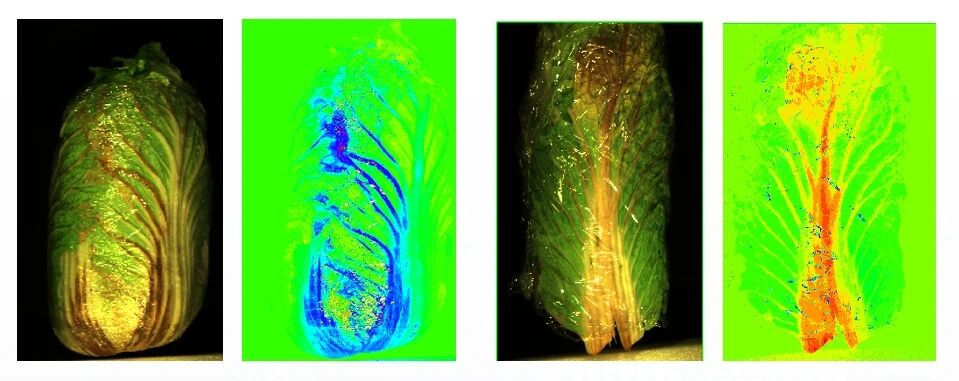Application and Analysis of Hyperspectral Technology in Cabbage Freshness Discrimination
食品新鲜度检测是食品安全与品质控制中的重要环节,直接关系到消费者的健康体验与营养摄入。对大众而言,食品新鲜度不仅影响食材的口感和营养价值,更是保障饮食安全、减少食源性疾病风险的关键因素。
Food freshness detection is a critical aspect of food safety and quality control, directly impacting consumers' health experiences and nutritional intake. For the public, food freshness not only influences the taste and nutritional value of ingredients but also plays a key role in ensuring dietary safety and reducing the risk of foodborne illnesses.

本次测试以不同新鲜程度的白菜为研究对象,利用高光谱技术实现对白菜新鲜度的有效区分。
This study used cabbages of different freshness levels as research subjects and employed hyperspectral technology to achieve effective discrimination of cabbage freshness.
本次测试所采用的高光谱相机覆盖400-1000nm的光谱范围,具备优于2.8nm的光谱分辨率,高达300个光谱波段,F/2的大光圈设计提升光通量,480个空间像素确保空间细节表现,采用CMOS探测器并结合USB接口实现便捷高效的数据传输,12bits的有效位深保障了图像数据的丰富层次与精度。该设备为农、林、食品检测等应用提供了有力工具,欢迎大家进一步了解。
测试采用线性推扫成像方案,照明光源为卤素光源。实验在暗室环境中进行,样品被放置于水平位移台上以完成图像采集。
The hyperspectral camera used in this test covers a spectral range of 400–1000 nm, with a spectral resolution better than 2.8 nm, up to 300 spectral bands, and an F/2 large aperture design that enhances light throughput. With 480 spatial pixels ensuring detailed spatial representation, it utilizes a CMOS detector combined with a USB interface for efficient data transmission. The 12-bit effective bit depth ensures rich image data hierarchy and precision. This device serves as a powerful tool for applications in agriculture, forestry, and food detection. Further inquiries are welcome.
The test adopted a linear push-broom imaging method, with a halogen light source for illumination. The experiment was conducted in a darkroom environment, and samples were placed on a horizontal translation stage for image acquisition.

测试样品及测试环境 / Test Samples and Testing Environment
通过获取不同新鲜度白菜在400-1000nm范围内的光谱曲线,并分别选取完好的茎与叶区域以及干枯的茎与叶区域计算平均光谱,分析表明:
完好的叶片(红色曲线)与干枯叶片(紫色曲线)在500-700nm和800-900nm波段的光谱响应存在明显差异;
完好的茎(绿色曲线)与干枯的茎(黄色曲线)则在650-850nm范围内表现出显著光谱变化。
By obtaining spectral curves of cabbages with different freshness levels within the 400–1000 nm range and calculating average spectra from intact stem and leaf regions as well as dried stem and leaf regions, the analysis revealed:
Significant differences in spectral responses between intact leaves (red curve) and dried leaves (purple curve) in the 500–700 nm and 800–900 nm bands;
intact stems (green curve) and dried stems (yellow curve) exhibited notable spectral variations within the 650–850 nm range.

反射率测试 / Reflectance Testing
在数据处理阶段,我们利用了两种不同的算法:
During data processing, two different algorithms were applied:
算法一选取枯叶ROI区域作为分类标准,能够有效识别部分白菜表面的干枯区域,但对茎部干枯区域的区分效果有限。
Algorithm 1 used dried leaf ROI regions as classification criteria, effectively identifying some dried areas on the cabbage surface but demonstrating limited ability to distinguish dried regions on stems.

算法一 / Algorithm 1
算法二通过对图像进行特征提取,实现了对表面干枯区域的更有效识别,从而对不同新鲜度的白菜实现了良好区分。
Algorithm 2 employed feature extraction from images, achieving more effective identification of surface-dried areas and enabling better discrimination of cabbages with different freshness levels.

算法二 / Algorithm 2
实验结果表明,基于400-1000nm波段的高光谱相机能够检测出不同新鲜程度白菜的光谱差异,且数据处理结果与实际状态相符。
Experimental results indicate that the hyperspectral camera based on the 400–1000 nm band can detect spectral differences in cabbages of varying freshness levels, and the data processing outcomes align with actual conditions.
本实验亦识别出若干实际测量中的难点:白菜表面覆盖的保鲜膜易引起光线反射,对信号造成干扰;同时,白菜的弧形表面不仅影响光线反射特性,也对相机的对焦精度提出了挑战。
针对这些问题,下一步计划包括优化光源结构、引入多角度照明方案,建立反射率校正模型以消除弧面造成的光谱强度偏差,提升数据可比性。此外,还将扩大样本数量,构建基于深度学习的新鲜度判别模型,以期实现更精确、可靠的白菜新鲜度分类能力,为实现更安全、更可靠的生鲜食品供应链提供了有效的技术保障。
This experiment also identified several challenges in practical measurements: The freshness-preserving film covering the cabbage surface easily causes light reflection, interfering with signals; meanwhile, the curved surface of the cabbage not only affects light reflection characteristics but also poses challenges to the camera’s focusing accuracy.
To address these issues, future plans include optimizing the light source structure, introducing multi-angle lighting schemes, and establishing a reflectance correction model to eliminate spectral intensity deviations caused by curved surfaces, thereby improving data comparability. Additionally, the sample size will be expanded to develop a deep learning-based freshness discrimination model, aiming to achieve more accurate and reliable cabbage freshness classification capabilities. This provides effective technical support for building a safer and more reliable fresh food supply chain.

上一篇:没有了
 客服热线:400-688-7769
客服热线:400-688-7769 邮箱:market@exponentsci.com
邮箱:market@exponentsci.com 固话:020-89858550
固话:020-89858550 地址:广州市天河区广汕二路602号惠诚大厦B座403房
地址:广州市天河区广汕二路602号惠诚大厦B座403房
扫一扫 微信咨询
©2025 爱博能(广州)科学技术有限公司 版权所有 备案号:粤ICP备20046466号 技术支持:化工仪器网 Sitemap.xml 总访问量:83155 管理登陆